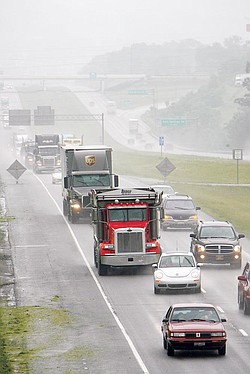Speed limit to rise for trucks
Trucks moving on 80 westbound in Weathersfield - the speed limit will soon be raised.
The state’s idea is to keep traffic moving in rural areas.
SALEM — Will a new speed limit for tractor-trailers on federal interstates in Ohio increase safety or hurt it?
Scott Varner, the deputy director for communications for the Ohio Department of Transportation thinks it will increase safety.
The Ohio State Highway Patrol isn’t so sure.
Here’s the situation:
As of Wednesday, ODOT will begin to post signs on the federally designated interstates that will allow truckers to drive 65 miles per hour. They presently are allowed to drive only 55 miles per hour.
Interstates also are legally defined in Ohio as four-lane highways with a divider. Turnpikes, state highways, such as state Route 11, and other federally designated roads are not affected. Interstates include: U.S. 90, U.S. 77, U.S. 71 and U.S. 75.
The change came because of the approval of House Bill 2 earlier this year.
However, the speed limits won’t go into effect until the road signs are up.
ODOT believes that traffic will flow evenly if cars and big trucks are traveling the same speed. Cars won’t have to constantly weave in and out around big trucks that are moving more slowly.
The change is aimed at vehicles in the rural areas of Ohio, Varner said, not metropolitan areas.
Drivers on interstates generally have to drive more slowly as they reach, enter and leave Ohio’s metropolitan areas.
The change may not be the final.
“We’ll see how this unfolds,” Varner said.
Lt. Shawn Davis, a spokesman for the Ohio State Highway Patrol, agreed.
“The jury is still out on this for us,” he said.
“We want to have traffic moving with a level of safety,” he added.
One of the issues in preventing crashing is that some of the big rigs can weigh over 4 tons.
But patrol statistics indicate that, statewide, crashes and injuries have decreased dramatically since 2004.
The statistics involve fatalities, injuries, property damage and unknown factors, which have gone down. The statistics statewide are for 2004 through 2008.
The Ohio Trucking Association supported the issue. David F. Bartosic, the communications director for the agency, deferred questions to Larry A. Davis, the president, who could not be reached.
Harry Evans Jr. of Middletown has run his own trucking business and been a driver for 51 years. He said the higher speed limit allows the trucks to run at its maximum performance.
“I just love to drive 65,” he said.
Having passing cars pull in front of a truck can be tragic. One of his drivers was killed in a wreck in Kentucky in 2004 when a car pulled in front of the truck, which then rolled and burned.
James McLaughlin, a trucker from Columbiana, said what other drivers and operators said. Despite the change, he thinks smart truckers would be sticking at 55 miles per hour.
The lower speed will use less fuel and allow for a profit, McLaughlin said.
Driving fast would burn more fuel and raise costs that truckers would have to absorb.
wilkinson@vindy.com
 43
43

